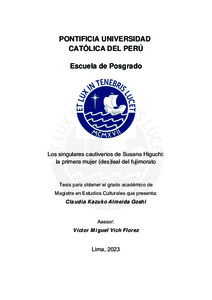| dc.contributor.advisor | Vich Florez, Victor Miguel | |
| dc.contributor.author | Almeida Goshi, Claudia Kazuko | |
| dc.date.accessioned | 2023-04-27T16:09:16Z | |
| dc.date.available | 2023-04-27T16:09:16Z | |
| dc.date.created | 2023 | |
| dc.date.issued | 2023-04-27 | |
| dc.identifier.uri | http://hdl.handle.net/20.500.12404/24825 | |
| dc.description.abstract | En este estudio de corte exploratorio bosquejo, a partir de un trabajo de hemeroteca, la
biografía de Susana Higuchi (1950-2021), ex primera dama del régimen de Alberto Fujimori
(1990-2000), y la interpreto a través de una constelación de voces provenientes,
principalmente, de diferentes perspectivas que se enmarcan en los Estudios de Género.
Autorxs como Maruja Barrig, Hélène Cixous, R. W. Connell, Simone de Beauvoir, Silvia
Federici, Luce Irigaray, Marcela Lagarde, Marta Lamas, María Emma Mannarelli, Kate Millett,
Carole Pateman, Adrianne Rich, Gayle Rubin, Flora Tristán y Monique Wittig (entre otrxs) me
ayudan a contemplar y a tomar distancia de la existencia de Susana Higuchi, a quien distingo
como la primera mujer (des)leal del fujimorato: ejecutora de la primera denuncia pública por
corrupción que apuntó al círculo presidencial más íntimo antes del autogolpe del 5 de abril de
1992. Ella pagaría las consecuencias de su traición y de develar parte del suplemento obsceno
(Žižek, 2003, 2011) del régimen (la corrupción como núcleo estructurador) al ser arrinconada
en lo que denomino el cautiverio de la paria; esto es, un abismo signado por la soledad y por
la desprotección extremas, donde las mujeres pueden ser arrojadas como castigo por
desequilibrar el status quo, por lo que dicen y por lo que hacen. Susana Higuchi se salvó de
caer en este encierro. Previamente, transitó por singulares cautiverios (en tanto hija, esposa y
madre) en los que supo maniobrar y acumular recursos simbólicos, así como económicos. Su
ocaso comenzó cuando se convirtió en la primera dama del fujimorato (1990-1994) y enfrentó
los escarmientos por ir más allá de los límites de «lo esperable». Ella sobrevivió y en su
momento habló en más de una ocasión. Con este trabajo, busco dar cuenta de su historia e
intento escuchar con atención su voz y sus silencios, los cuales atravesaron la tan poco
estudiada en nuestro país historia del tiempo presente. | es_ES |
| dc.description.abstract | This study takes on an exploratory approach and looks into the biography of Susana Higuchi
(1950-2021), first lady of Peru during Alberto Fujimori's regime (1990-2000). Drawing on a
systematic review of periodicals, I interpret Higuchi’s biography through the lens of different
authors and perspectives from the field of Gender Studies. Authors such as Maruja Barrig,
Hélène Cixous, R. W. Connell, Simone de Beauvoir, Silvia Federici, Luce Irigaray, Marcela
Lagarde, Marta Lamas, María Emma Mannarelli, Kate Millett, Carole Pateman, Adrianne
Rich, Gayle Rubin, Flora Tristán, Monique Wittig, amongst others, help me assess and gain
perspective into Susana Higuchi’s life history I regard Higuchi as the first woman to be
(dis)loyal to fujimorato: leading the first public denounce of corruption involving closest
members of the presidential circle during the time prior to Fujimori’s self-coup on April 5th,
1992. Higuchi faced the consequences of her treason. For unveiling part of the obscene
supplement (Žižek, 2003, 2011) of the regime (i.e., corruption as the structuring nucleus), she
was confined into what I refer to as the pariah’s captivity. This analytical figure represents an
abyss characterised by loneliness and utter abandonment, where women get thrown into as
punishment for breaking the status quo, for the things they say and do. Susana Higuchi saved
herself from falling into such an enclosure. Previously, she had walked through particular
captivities (as daughter, wife, and mother) where she was able to accumulate and manage
symbolic and economic capital. Her downfall began when she became the first lady of
fujimorato (1990-1994) as she experienced chastisement for going beyond the limits of ‘what’s
hoped’. She survived and spoke out more than once. In this study, I aim to provide an account
into her life history and listen attentively to her voice and silences, which run across the
understudied history of our country’s present time. | es_ES |
| dc.language.iso | spa | es_ES |
| dc.publisher | Pontificia Universidad Católica del Perú | es_ES |
| dc.rights | info:eu-repo/semantics/embargoedAccess | es_ES |
| dc.rights.uri | http://creativecommons.org/licenses/by-nc-nd/2.5/pe/ | * |
| dc.subject | Higuchi, Susana--Biografía | es_ES |
| dc.subject | Cautiverio--Perú--Lima | es_ES |
| dc.subject | Tortura--Perú--Lima | es_ES |
| dc.subject | Fujimori Fujimori, Alberto | es_ES |
| dc.subject | Violencia contra la mujer--Perú--Lima | es_ES |
| dc.subject | Perú--Política y gobierno--1990-2000 | es_ES |
| dc.title | Los singulares cautiverios de Susana Higuchi: la primera mujer (des)leal del fujimorato | es_ES |
| dc.type | info:eu-repo/semantics/masterThesis | es_ES |
| thesis.degree.name | Maestro en Estudios Culturales | es_ES |
| thesis.degree.level | Maestría | es_ES |
| thesis.degree.grantor | Pontificia Universidad Católica del Perú. Escuela de Posgrado. | es_ES |
| thesis.degree.discipline | Estudios Culturales | es_ES |
| renati.advisor.dni | 09389668 | |
| renati.advisor.orcid | https://orcid.org/0000-0003-4192-6873 | es_ES |
| renati.author.dni | 44059815 | |
| renati.discipline | 314317 | es_ES |
| renati.juror | Hibbett Diez Canseco, Alexandra Imogen | es_ES |
| renati.juror | Vich Florez, Victor Miguel | es_ES |
| renati.juror | Ubilluz Raygada, Juan Carlos | es_ES |
| renati.level | https://purl.org/pe-repo/renati/level#maestro | es_ES |
| renati.type | https://purl.org/pe-repo/renati/type#tesis | es_ES |
| dc.date.EmbargoEnd | 2025-04-26 | |
| dc.publisher.country | PE | es_ES |
| dc.subject.ocde | https://purl.org/pe-repo/ocde/ford#5.09.00 | es_ES |







